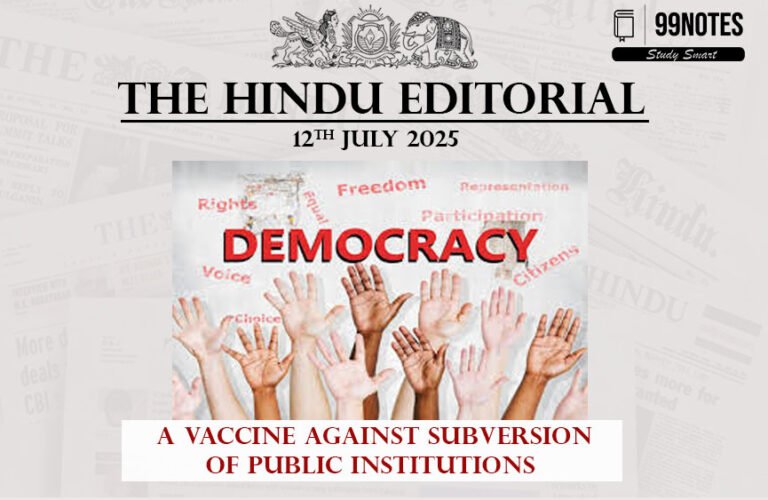21 June 2023 : The Hindu Editorial
The Hindu Editorial
21-June-2023
Daily Current Affairs For UPSC ,The Hindu Editorial Summary
1. Semiconductor fab: the unfinished agenda.
Topic: GS3 – Semiconductor exploration
Why in the news:
-
-
-
The growing market for semiconductors in India makes it a viable endeavor.
-
India’s dependence on imported semiconductors increases its susceptibility to coercion.
-
The government’s 2022 Semiconductor Mission is commendable.
-
However, there is uncertainty regarding whether India will succeed in establishing a semiconductor fabrication plant.
-
It is crucial to analyze previous failed attempts and explore alternative approaches to overcome challenges.
-
-
What is Semiconductor fab:
-
-
-
A semiconductor fab, also known as a semiconductor fabrication facility or semiconductor manufacturing plant, is a specialized facility where semiconductor devices, such as integrated circuits (ICs) or chips, are manufactured.
-
It is a highly advanced and complex facility that involves various processes to produce electronic components on a microscopic scale.
-
Semiconductor fabs play a crucial role in the electronics industry as they are responsible for the mass production of integrated circuits and other semiconductor devices used in computers, smartphones, consumer electronics, automotive systems, medical devices, and more.
-
-
Earlier attempts for semiconductor exploration:
-
-
-
Previous attempts to establish a semiconductor fabrication plant in India were made in 2007 and 2012, but both failed to mobilize resources.
-
Semiconductor fabrication involves increasing complexity and costs due to the progress of miniaturization.
-
China, with massive government support, has become a major player in the chip-making industry.
-
The U.S. and its allies have blocked the transfer of fab-related technology to China, leading to intense chip warfare.
-
Investment in a semiconductor fab is risky, requiring substantial production volumes and global sales for economic viability.
-
Developing an ecosystem for chip manufacturing is challenging, including the availability of chemicals, trained personnel, and clean water.
-
Assembly, Testing, Packaging, and Marking (ATMP) is a potential intermediate step before setting up a full-fledged fab.
-
-
Lessons from China for India:
-
-
-
India’s strategy is to set up a new logic fab in order to strengthen its semiconductor industry.
-
China’s approach of acquiring existing fabs provides valuable lessons for India.
-
Acquiring existing fabs offers advantages such as reasonable pricing, stabilized technology, established supply chain ecosystems, existing product lines, and market presence.
-
Acquiring existing fabs will help India build the fab ecosystem, train human resources, and require lower subsidies.
-
The saved funds can be utilized for advanced research and development (R&D) in fab technologies.
-
Another strategy could be setting up Assembly, Testing, Packaging, and Marking (ATMP) facilities.
-
ATMP facilities can help build the fab ecosystem and successfully package chips with advanced feature sizes.
-
-
Significance of semiconductor fab for India:
-
-
-
Strengthening Domestic Semiconductor Industry: This would reduce India’s dependence on imported semiconductors and enhance the country’s self-sufficiency in this critical technology sector.
-
Boosting Manufacturing and Job Creation: The establishment of a semiconductor fab would lead to the creation of a robust manufacturing ecosystem. It would generate employment opportunities for skilled professionals in various fields, including semiconductor manufacturing, research and development, engineering, and related support services.
-
Advancing Technological Capabilities: A semiconductor fab would enable India to acquire advanced technological capabilities in chip fabrication. It would provide access to cutting-edge equipment, processes, and expertise, fostering innovation and research in semiconductor technology.
-
Enhancing National Security: Developing indigenous semiconductor manufacturing capabilities is crucial for national security. It reduces vulnerabilities arising from dependence on imported semiconductors, which can be subject to supply chain disruptions or potential security risks.
-
Attracting Investments and fostering innovation: A semiconductor fab in India would attract investments from both domestic and international semiconductor companies. It would facilitate technology transfer, research collaborations, and partnerships, leading to knowledge exchange and fostering a vibrant semiconductor ecosystem.
-
Strategic Independence: By having a semiconductor fab, India can reduce its susceptibility to coercion and supply chain disruptions in the semiconductor industry. It would enhance India’s strategic independence and strengthen its position in global technology markets.
-
-
Way forward for growth of semiconductor industry:
-
-
-
Government Support and Policies: This includes offering attractive incentives, tax breaks, and regulatory reforms to attract both domestic and foreign investments.
-
Public-Private Partnerships: Encourage public-private partnerships to pool resources, share expertise, and promote research and development in semiconductor technology.
-
Skill Development and Human Resources: Invest in skill development programs to create a pool of trained professionals specialized in semiconductor manufacturing and related areas.
-
R&D and Innovation: Allocate resources for advanced research and development in semiconductor technology. Encourage innovation in chip design, fabrication processes, and materials to stay at the forefront of technological advancements and address future market demands.
-
Infrastructure Development: Focus on developing robust infrastructure to support semiconductor fabs, including cleanroom facilities, reliable power supply, water management systems, and transportation networks.
-
International Collaboration: Foster partnerships with leading semiconductor companies and organizations globally to leverage their expertise, technology, and market access. Encourage knowledge sharing, joint research projects, and technology transfer to accelerate the development of semiconductor fabs in India.
-
Regulatory Framework: Establish a supportive and streamlined regulatory framework that ensures ease of doing business, protects intellectual property rights, and facilitates technology transfer while maintaining security protocols and standards.
-
-
Conclusion:
By implementing these strategies, India can create a conducive ecosystem for semiconductor fabs. This would contribute to India’s economic growth, technological self-reliance, and global competitiveness in the semiconductor sector.
Source: https://www.thehindu.com/opinion/op-ed/semiconductor-fab-the-unfinished-agenda/article66990739.ece
2. American culture’s over-reliance on police to maintain order in public life is problematic
Topic: GS2 – Law and order.
Context:
-
-
-
The U.S. Department of Justice conducted investigation into violence and racial discrimination by the police in Minneapolis, following the murder of George Floyd.
-
The investigation found that officers had used excessive force, violated the rights of individuals engaged in constitutionally protected speech, and discriminated against African-American.
-
-
Why over-reliance on police for maintaining law and order can problematic in India:
-
-
-
Limited resources and capacity: The police force in India often faces challenges of limited resources, including manpower and equipment. The burden of maintaining order solely on the police can strain their capabilities and hinder their ability to respond effectively to all situations.
-
Lack of specialized training: Police officers receive training primarily focused on law enforcement and crime control. However, they may not always have the necessary expertise or training to handle complex social issues, such as mental health crises, domestic disputes, or community conflicts.
-
Potential for misuse of power: Over-reliance on the police can create a power dynamic that may be prone to abuse. It can empower individual officers to exercise discretionary powers, which can result in the violation of civil rights, corruption, or disproportionate use of force.
-
Inadequate community engagement: Effective maintenance of order requires proactive involvement from the community, including social organizations, local leaders, and residents. Building trust and fostering cooperation between the community and law enforcement is essential for sustainable peace.
-
Need for a comprehensive approach: Maintaining order is not solely the responsibility of the police. It requires a multi-faceted approach that involves addressing social, economic, and political factors contributing to unrest. Inclusive policies, access to justice, social welfare programs, and community development initiatives play crucial roles in ensuring long-term stability.
-
-
3. A welcome step: on the Blinken-Xi meet in China.
Topic: GS2 – International relations
Context:
-
-
-
Antony Blinken, U.S. Secretary of State, visited Beijing, marking the first visit by a U.S. Secretary of State since 2018.
-
The main outcome of the visit was an agreement between the U.S. and China on the need for stability in their relations.
-
The objective of the visit was to strengthen communication, clarify positions on disagreements, and explore areas of potential cooperation on shared challenges.
-
The challenge now is to sustain the effort to improve relations and keep diplomatic channels open, especially in the face of future crises and domestic political rhetoric.
-
-
Need for stable USA China relationship from global perspective:
-
-
-
Economic Stability: The United States and China are the world’s two largest economies. A stable relationship between them is crucial for global economic stability and growth. Disruptions or conflicts in their relationship can have far-reaching consequences, affecting trade, investment, supply chains, and financial markets worldwide.
-
Trade and Global Supply Chains: Both countries play a vital role in global trade and supply chains. A stable relationship is essential for fostering trade cooperation, addressing trade imbalances, and ensuring the smooth functioning of international commerce. Any disruptions or trade conflicts between the two can have adverse effects on global trade flows and economic interconnectedness.
-
Regional and Global Security: The United States and China are major players in regional and global security dynamics. Maintaining a stable relationship helps reduce tensions, promotes dialogue, and facilitates cooperation on critical security issues such as non-proliferation, counterterrorism, and regional stability. A destabilized relationship could lead to a heightened risk of conflicts or miscalculations with global ramifications.
-
Climate Change and Environmental Cooperation: The United States and China are the world’s top two emitters of greenhouse gases. Collaboration between them is vital to address climate change and achieve global climate goals. A stable relationship enables joint efforts in areas such as renewable energy, emission reductions, and environmental protection, leading to a more sustainable future.
-
Multilateralism and Global Governance: The United States and China’s engagement and cooperation are essential for the effective functioning of multilateral institutions and global governance frameworks. Their alignment on key global challenges such as public health, poverty eradication, human rights, and peacekeeping efforts strengthens the international order and fosters collective solutions.
-
Technological Advancements and Innovation: Both countries are at the forefront of technological advancements and innovation. Collaboration and exchange of knowledge between the United States and China can drive global progress in areas such as artificial intelligence, biotechnology, space exploration, and digital transformation.
-
-
For Enquiry

21 June 2023 : The Hindu Editorial

21 June 2023 : Daily Current Affairs

20 June 2023 : Indian Express

20 June 2023 : Daily Quiz

20 June 2023 : PIB

20 June 2023 : The Hindu Editorial

20 June 2023 : Daily Current Affairs

19 June 2023 : Indian Express

19 June 2023 : Daily Quiz

19 June 2023 : PIB
The Hindu 21 June 2023 : The Hindu Editorial The Hindu Editorial
20-June-2023
Daily Current Affairs For UPSC ,The Hindu Editorial Summary
Facebook-f
Twitter
Youtube
1….
Daily Current Affairs 21 June 2023 : Daily Current Affairs DAILY CURRENT AFFAIRS
21-June-2023
Daily Current Affairs For UPSC ,Daily Current affairs of The hIndu…
Indian Express 20 June 2023 : Indian Express Indian Express
20-June-2023
The Indian Express, CSE candidates can stay informed about current events…
Daily Quiz 20 June 2023 : Daily Quiz 20 June 2023 : Daily Quiz…
PIB 20 June 2023 : PIB PRESS INFORMATION BUREAU
20-June-2023
Daily Current Affairs For UPSC ,The PIB ( Press Information Bureau…
The Hindu 20 June 2023 : The Hindu Editorial The Hindu Editorial
20-June-2023
Daily Current Affairs For UPSC ,The Hindu Editorial Summary
Facebook-f
Twitter
Youtube…
Daily Current Affairs 20 June 2023 : Daily Current Affairs DAILY CURRENT AFFAIRS
20-June-2023
Daily Current Affairs For UPSC ,Daily Current affairs of The hIndu…
Indian Express 19 June 2023 : Indian Express Indian Express
19-June-2023
The Indian Express, CSE candidates can stay informed about current events…
Daily Quiz 19 June 2023 : Daily Quiz 19 June 2023 : Daily Quiz…
PIB 19 June 2023 : PIB PRESS INFORMATION BUREAU
19-June-2023
Daily Current Affairs For UPSC ,The PIB ( Press Information Bureau…




